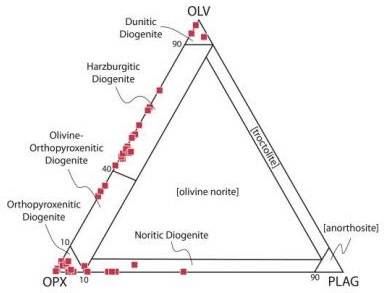Systematics: Diogenites – Classification Based on IUGS Taxonomy
PART I: CHONDRITES, METACHONDRITES
PART II: PRIMITIVE ACHONDRITES, ACHONDRITES, STONY-IRONS, IRONS
PART III: MARTIAN METEORITES—GEOCHEMICAL CLASSIFICATION
PART V: ENSTATITE CHONDRITES—SUBGROUP CLASSIFICATION
DIOGENITES
HED (VestaThird largest and fourth brightest asteroid; it was discovered in 1807 by Heinrich Olbers and named for the ancient Roman goddess of the hearth. 4 Vesta has a basaltic surface composition and an average density not much less than that of Mars. Evidently lava once flowed here indicating that the) material of ultramaficTerm used for silicate minerals with cations predominantly Mg and/or Fe. Mafic minerals are dominated by plagioclase and pyroxene, and also contain smaller amounts of olivine. Click on Term to Read More composition (olivine+orthopyroxeneOrthorhombic, low-Ca pyroxene common in chondrites. Its compositional range runs from all Mg-rich enstatite, MgSiO3 to Fe-rich ferrosilite, FeSiO3. These end-members form an almost complete solid solution where Mg substitutes for Fe up to about 90 mol. % and Ca substitutes no more than ~5 mol. % (higher Ca contents occur Click on Term to Read More ≥90 vol%)
Classification Based on IUGS Taxonomy
| DIOGENITESDiogenites belong to the evolved achondrite HED group that also includes howardites and eucrites. They are named after the Greek philosopher Diogenes of Apollonia, of the 5th century BCE, who was the first to suggest that meteorites come from outer space (a realization forgotten for over 2,000 years). They are Click on Term to Read More (6 subclasses known based on modal mineralogy) |
| 1. ORTHOPYROXENITIC: ≥90 vol% orthopyroxene (e.g. Bilanga, Johnstown, NWA 1821, NWA 3329, QUE 99050, Tatahouine) |
| 2. OLIVINE–ORTHOPYROXENITIC: orthopyroxene + 10–40 vol% olivineGroup of silicate minerals, (Mg,Fe)2SiO4, with the compositional endpoints of forsterite (Mg2SiO4) and fayalite (Fe2SiO4). Olivine is commonly found in all chondrites within both the matrix and chondrules, achondrites including most primitive achondrites and some evolved achondrites, in pallasites as large yellow-green crystals (brown when terrestrialized), in the silicate portion Click on Term to Read More (e.g. ALHA77256, GRA 98108, LEW 88679, NWA 5312, NWA 5405) |
| 3. HARZBURGITIC: >40 vol% olivine (e.g. EETA79002, MIL 07001, NWA 1459, 1877 and pairings, NWA 4223, NWA 5480, NWA 6157) |
| 4. DUNITIC: ≥90 vol% olivine (e.g. MIL 03443, NWA 2968) |
| 5. NORITIC: orthopyroxene + <5 vol% olivine + >10 vol% plagioclaseAlso referred to as the plagioclase feldspar series. Plagioclase is a common rock-forming series of feldspar minerals containing a continuous solid solution of calcium and sodium: (Na1-x,Cax)(Alx+1,Si1-x)Si2O8 where x = 0 to 1. The Ca-rich end-member is called anorthite (pure anorthite has formula: CaAl2Si2O8) and the Na-rich end-member is albite Click on Term to Read More (e.g. NWA 5315, NWA 6928, NWA 8000, NWA 8367, NWA 8744, NWA 10268, NWA 10388) |
| 6. POLYMICT: dunite ± harzburgite ± orthopyroxeniteA rock composed primarily of orthopyroxene. Non-terrestrial orthopyoxenites include diogenites and a single martian meteorite, ALH 84001, that was found in the Allan Hills region of Antarctica in 1984. ALH 84001 is a cumulate rock consisting of 97% coarse-grained, Mg-rich orthopyroxene, with small amounts of plagioclase, chromite, and carbonate. It Click on Term to Read More ± eucriteMost common type of achondrite meteorite and a member of the HED group. Eucrites are basalts composed primarily of pigeonite and anorthite (An60-98). Eucrites have been placed into three subgroups based on mineralogical and chemical differences. • Non-cumulate eucrites represent the upper crust that solidified on a magma ocean after Click on Term to Read More (<10 vol%) (e.g. ALH 85015, LEW 88008, NWA 1239, NWA 1648, NWA 4473, NWA 6945 [w/ noritic clasts]) |

Diagram credit: Irving et al., 47th LPSC, #2264 (2016)
According to Beck and McSween (2010), diogenites represent two separate ultramafic lithologies formed by fractional crystallizationA crystallization process in which minerals crystallizing from a magma are isolated from contact with the liquid. It is a key process in the formation of igneous rocks during the process of magmatic differentiation. Also known as crystal fractionation. Click on Term to Read More in multiple plutons. Of these two lithologies, one consists of olivine + magnesian orthopyroxene, and the other consists of ferroan orthopyroxene. It is thought that these two lithologies occur in varying amounts among the different diogenites as a result of brecciationThe formation of a breccia through a process by which rock fragments of of various types are recemented or fused together. Click on Term to Read More and mixing, sometimes forming polymict diogenites containing olivine with two pyroxenes.
The diogeniteDiogenites belong to the evolved achondrite HED group that also includes howardites and eucrites. They are named after the Greek philosopher Diogenes of Apollonia, of the 5th century BCE, who was the first to suggest that meteorites come from outer space (a realization forgotten for over 2,000 years). They are Click on Term to Read More classification scheme and data used on this page are adapted from Beck and McSween Jr., MAPS, vol. 45, #5, pp. 850-872 (2010). An extension of their scheme was suggested by Wittke et al. (2011). The diogeniteDiogenites belong to the evolved achondrite HED group that also includes howardites and eucrites. They are named after the Greek philosopher Diogenes of Apollonia, of the 5th century BCE, who was the first to suggest that meteorites come from outer space (a realization forgotten for over 2,000 years). They are Click on Term to Read More classification ternary diagram shown below is from Wittke et al. 74th MetSoc, #5223 (2011).

PART I: CHONDRITES, METACHONDRITES
PART II: PRIMITIVE ACHONDRITES, ACHONDRITES, STONY-IRONS, IRONS
PART III: MARTIAN METEORITES—GEOCHEMICAL CLASSIFICATION
PART V: ENSTATITE CHONDRITES—SUBGROUP CLASSIFICATION
You must collect things for reasons you don’t yet understand.
Daniel J. Boorstin – Librarian of Congress
© 1997–2019 by David Weir






